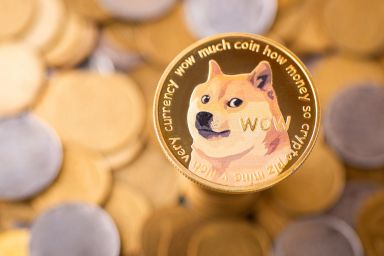Latest crypto-currencies articles




HomeMarketsCryptocurrenciesDogeCoin to US Dollar
This financial market is available for CFD trading. Learn more about:CFDs | CFD | ||||
| Spread | 0.0006990 | ||||
Long position overnight funding adjustment
Trade size with leverage ~ $20,000.00 Money from leverage ~ $$19,000.00 | -0.06164% | ||||
Short position overnight funding adjustment
Trade size with leverage ~ $20,000.00 Money from leverage ~ $$19,000.00 | 0.01370% | ||||
| Overnight funding adjustment time | 22:00 (UTC) | ||||
| Currency | USD | ||||
| Min traded quantity | 10 | ||||
| Margin | 5.00% | ||||
| Stock exchange | |||||
| Commission on trade1 | 0% | ||||
A guaranteed stop-loss (GSL) fee is only charged if the GSL is triggered. Please consult the Charges and Fees section of our website for more details. | 0.5% |
1Our charge for executing your trade is the spread, the difference between the buy and sell price. Please consult the Charges and Fees section of our website for further information




I'm learning the basics of stock inv
Great customer service I got to say that. They helped get my account back very fast, after i logged myself out by losing my old email, it was so fast you wouldn’t believe it thank you once again.
Everything worked as expected from the 1 day. I didn’t have to search how to use the platform, it’s intuitive. The support chat was there when I had a tiny issue.
Capital.com has been great for both learning and trading. The app is clean, fast, and packed with useful tools. Customer support has been solid too. Definitely recommended for beginners and active traders alike.
I trade every day and Capital is my beloved home. I also create music and you can always feel when something has been created from the heart. Capital has soul!
The app is built to make op
Deposits and withdrawals work with
I would like to express a huge thank you to Evgeniya Logvinovich, customer service manager. For your attention and heartfelt attitude to your clients.❤️
I am extremely happy with this broker. Great spreads, good selection of instruments, well coded toolbox.
Love the TV integration. Makes traders life smooth and comfortable.
I trade every day and Capital is my beloved home. I also create music and you can always feel when something has been created from the heart. Capital has soul!
I’d been paper trading for 2yrs now, went live and this platform is easy for beginners to understand and navigate all important tools to execute all that I learned. Earning now!
This application is perfect.. simple, easy to use, run smoothly and fast and it has an accurate graphics.. be careful to use only one credit card and one bank account to prevent any withdrawal problem.. overnight fees and spread variation will be repaid for you by the next month.. I used many application but this is the best one
User friendly app & interface and good support team. Funds transfer ease & Leverage is an advantage but crypto is highly risky be responsible of your loss limits and risks appetite.
Capital is really great to be used on start, also beginner friendly broker! Great costumer support and it is quick!
Showing our 4 & 5 star reviews. The specific details of the user have been intentionally anonymised to safeguard their privacy pursuant to GDPR requirements.